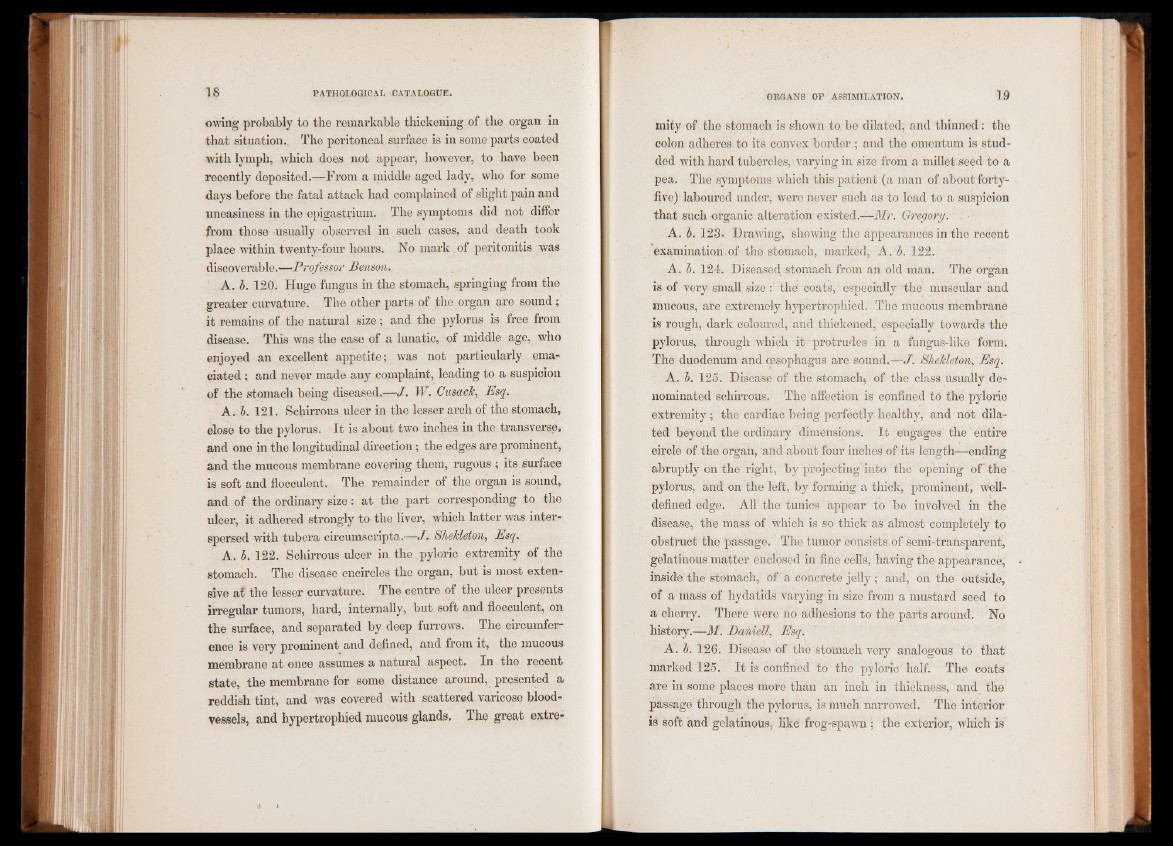
owing probably to the remarkable thickening of the organ in
that situation.. The peritoneal, surface is in some parts coated
with lymph, .which does not appear, however, to have been
recently deposited.—From a middle aged lady, who for some
days before the fatal attack had complained of slight pain and
uneasiness in the epigastrium. The symptoms did not differ
from those usually observed in such cases, and death took
place within twenty-four hours. No mark of peritonitis was
discoverable.—Professor Benson..
A.b. 120. Huge fungus in the stomach, springing from the
greater curvature. The other parts of the organ are sound ;
it remains of the natural size; and the pylorus is free from
disease. This was the case of a lunatic, of middle age, who
enjoyed an excellent appetite; was not particularly emaciated
; and never made any complaint, leading to a suspicion
of the stomach being diseased*^—J. W. Cusack, Esq.
A. b. 121. Schirrous ulcer in the lesser arch of the stomach,
close to the pylorus. It is about two inches in the transverse,
and one in the longitudinal direction; the edges are prominent,
and the mucous membrane covering them, rugous ; its surface
is soft and flocculent. The remainder of the organ is sound,
and of the ordinary size: at the part corresponding to the
ulcer, it adhered strongly to the liver, which latter was interspersed
with tubera circumscripta.—J . SheMeton, Esq.
A. b. 122. Schirrous ulcer in the pyloric extremity of the
stomach. The disease encircles the organ, but is most extensive
at the lesser curvature. The centre of the ulcer presents
irregular tumors, hard, internally, but soft and flocculent, on
the surface, and separated by deep furrows. The circumference
is very prominent and defined, and from it, the mucous
membrane at once assumes a natural aspect. In the recent
state, the membrane for some distance around, presented a
reddish tint, and was covered with scattered varicose bloodvessels,
and hypertrophied mucous glands. The great extremity
of the stomach is shown to be dilated, and thinned: the
colon adheres to its convex border; and the omentum is studded
with hard tubercles, varying in size from a millet: seed to a
pea. The symptoms which this patient (a man of about forty-
five) laboured under, were never such as to lead to a suspicion
that such organic alteration existed.—Mr. Gregory. .
A. b. 123.. Drawing, showing the appearances in the recent
. examination.of the stomach, marked, A. b. 122.
A. b. 124. Diseased stomach from an old man. The organ
is of very small size : the' coats, especially the - muscular and
mucous, are extremely hypertrophied. The mucous membrane
is rough, dark coloured, and thickened, especially towards the
pylorus, through which it protrudes in. a fungus-like form.
The duodenum and oesophagus are sound.—J. SheMeton, Esq.
A. b. 125. Disease of the stomachy of the class, usually denominated
schirrous. The affection is confined to the pyloric
extremity; the cardiac being perfectly healthy, and not dilated
beyond the ordinary dimensions. It engages'the entire
circle of the organ, and about four inches of its length—ending
abruptly on the right, by projecting into the opening of" the
pylorus, and on the left, by forming a thick, prominent, well-
defined edge. All the'tunics appear to be involved in the
disease, the mass of which is so thick as almost completely to
obstruct the passage. The tumor consists, of semi-transparent,
gelatinous matter enclosed in fine cells, having the appearance,
inside the stomach, of a concrete jelly ; and, on the outside,
of a mass of hydatids varying in size from a mustard seed to
a cherry. There were no adhesions to the parts around. No
history.—M. Daniell, Esq.
A. b. 126. Disease of the stomach very analogous to that
marked 125. It is confined to the pyloric half. The Coats
are in some places more than an inch in thickness, and the
passage through the pylorus, is much narrowed. The interior
is soft and gelatinous, like frog-spawn; the exterior, which is'